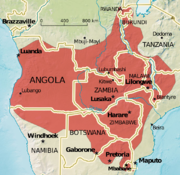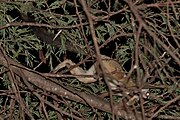Lesser bushbaby
| Galago[1] | |
|---|---|

| |
| Senegal bushbaby (G. senegalensis) | |
| Scientific classification | |
| Domain: | Eukaryota |
| Kingdom: | Animalia |
| Phylum: | Chordata |
| Class: | Mammalia |
| Order: | Primates |
| Suborder: | Strepsirrhini |
| Family: | Galagidae |
| Genus: | Galago É. Geoffroy, 1796 |
| Type species | |
Galago senegalensis
, 1796 | |
| Species | |
|
| |
Lesser bushbabies, or lesser galagos, are
They mark their territory by urinating on their hands and leaving traces on the trees they climb across, and they follow these detectable paths through the trees night after night. Males will also urinate on females to mark them. They are related to lorises, and have similar behavior and anatomy. They are much faster, however, and typically hunt by speed rather than by stealth.[2] Primitive bushbabies are thought to have been the ancestors of all lemurs.[2]
Appearance
Lesser bushbabies are small, woolly primates with long tails and oversized, naked ears. Different species are sometimes indistinguishable even when compared side by side.[4] Additionally, there is often notable variation in coloration and body size even within species and populations.[5] Their coat varies across body regions as well as between species, typically ranging from black, brown, and grey to white, with many showing a greenish, reddish, and orangeish tint to the sides and limbs. Some species have a nasal strip while others have distinct dark rings around the eyes.[4]
Their neck is very flexible, so that the head can turn 180 degrees,[6] which gives them a broad field of vision which is helpful in locating prey; they also have highly mobile ears that allow them to track insects as they hunt. Round flat pads on their fingertips, between their fingers, and on their palms at the base of their thumbs enable them to firmly grip the branches.[7] They also have pointed, keeled nails that give them stability as they cling to smooth tree surfaces and reach for insects into crevices, using their rough narrow tongue.[3]
Distribution and habitat
Lesser bushbabies are distributed through most of
Lesser bushbabies are found in a variety of
Diet
Bushbabies generally consume three types of food in various proportions and combinations: animal prey,
Behavior
Galagos are tree dwelling primates and are capable of leaping significant distances, up to and sometimes greater than 2.5 metres (8 ft 2 in),
Galagos are
Bushbabies are solitary foragers, however they do meet up at night in groups. Some species, such as
Breeding

Lesser bushbabies usually give birth during the rainy season. The offspring are usually twins.[16] After the birth there is usually a second period of heat. A female’s gestation period is between 111–142 days and will usually consist of the female mating with up to 6 different males.[11][17]
Lesser bushbaby mothers initially shelter their offspring in a nest or tree hollow, later on concealing the infants in foliage while they forage at night.[16]
Taxonomy
| Common name | Scientific name and subspecies | Range | Size and ecology | IUCN status and estimated population |
|---|---|---|---|---|
| Dusky bushbaby
|
G. matschiei Liburnau, 1917 |
Central Africa
|
Size: 14–19 cm (6–7 in) long, plus 24–28 cm (9–11 in) tail[18] Habitat: Forest[19] Diet: Insects, fruit, flowers, and gum[18] |
LC
|
| Mohol bushbaby | G. moholi Smith, 1836 |
Central and southern Africa
|
Size: 14–17 cm (6–7 in) long, plus 11–28 cm (4–11 in) tail[20] Habitat: Savanna[21] Diet: Arthropods, as well as tree gum and resin[20] |
LC
|
| Senegal bushbaby | G. senegalensis É Geoffroy, 1796 Four subspecies
|
Equatorial Africa (possible additional range in red)
|
Size: 13–21 cm (5–8 in) long, plus 19–30 cm (7–12 in) tail[22] Habitat: Forest and savanna[23] Diet: Insects, as well as small birds, eggs, fruits, seeds, flowers, and tree gum[24] |
LC
|
| Somali bushbaby | G. gallarum Thomas, 1901 |
Eastern Africa
|
Size: 13–20 cm (5–8 in) long, plus 20–30 cm (8–12 in) tail[22] Habitat: Savanna[25] Diet: Gum and invertebrates[22] |
LC
|
References
- ^ OCLC 62265494.
- ^ Life of Mammals, Episode 8: Life in the Trees. BBC Warner, 2003.
- ^ a b Abrams, Sylvie (November 2016). "Lesser Galago". New England Primate Conservatory. Archived from the original on 2020-10-26. Retrieved 2020-10-23.
- ^ a b c "Lesser bushbaby". WNPRC.
- S2CID 23422588.
- ISBN 9780079095084.
- ISBN 9780811814348.
- ISBN 978-0-12-378632-6.
- ISBN 9781431701902.)
{{cite book}}: CS1 maint: location missing publisher (link - .
- ^ a b c "Lesser Bushbaby". Siyabona Africa. Retrieved 10 March 2012.
- S2CID 209843888.
- ISBN 9780849363207.
- ^ Bearder, Simon (1995). "Calls of the Wild". Natural History. 104: 48–57.
- ^ a b Poynter, Therien. "Galago moholi (South African galago)". Animal Diversity Web.
- ^ ISBN 978-0-19-150342-9. Retrieved 28 April 2013.
- ^ Fitterer, Carolynn. "Galago gabonensis (Gabon bushbaby)". Animal Diversity Web.
- ^ a b Kingdon et al., p. 440
- ^ .
- ^ a b Poynter, Therien (2009). "Galago moholi". Animal Diversity Web. University of Michigan. Retrieved June 25, 2023.
- ^ .
- ^ a b c Kingdon, ch. Galagos
- ^ .
- ^ Ballenger, Liz (2001). "Galago senegalensis". Animal Diversity Web. University of Michigan. Retrieved June 25, 2023.
- ^ .
External links
 Data related to Galago (Lesser bushbaby) at Wikispecies
Data related to Galago (Lesser bushbaby) at Wikispecies- Primate Info Net Galago Factsheet
- "Galago senegalensis". Retrieved 8 March 2012.



